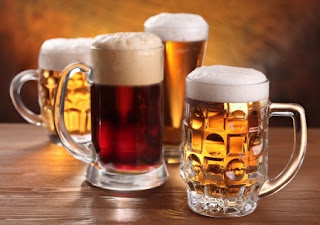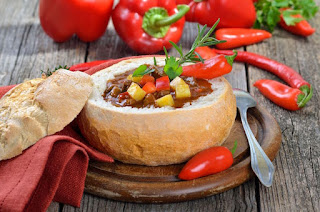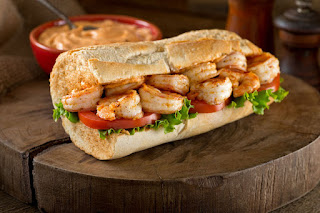 |
| Mugs of different beer |
The Science of Beer and Food Pairing
Beer gets its flavor and style from the combination of its three main ingredients—grains, hops and yeast. The complexity of flavors, textures and strengths comes from the malting and roasting processes and the proportion of blending different malts and grains.Hops provide bitterness and yeast contributes to a range of secondary flavors like fruity, bread-like, sour. Additionally, these three ingredients also influence the aroma of the beer, which is important as our sense of taste is connected to smell.
 |
| Different beer ingredients and beer styles |
The important aspect of pairing is to achieve balance of flavor and body, as the food should not overpower the beer or the beer should not bury the flavor of the food.
The objective of pairing beer with food must seek to harmonize the flavors and the mouthfeel to create a dining experience that is enjoyable and brings out the best from the combination of different flavors present in the food and beer.
The flavors and mouthfeel of the beer come from its three main ingredients—grains, hops and yeast and the carbonation process. To clearly understand the science of pairing food and beer, it is important to understand the influence of these ingredients on pairing besides the influence of the beer carbonation process.
Influence of Grains on Pairing
Grains are the foundation of the beer and besides flavor also gives the beer its texture and depth.Barley which is the most common grain used for making malt, provides sweetness and malt flavor besides the sugars needed to create alcohol. Oats give a smooth richness to the body and adds a smooth, rich, creamy texture to the stouts. Rye adds a crisp, slightly spicy, sometimes dry aspect to the beer. Rice and corn, are neutral grains that do not change the taste but tend to lighten flavor.
 |
| Chocolate malt, crystal malt, and pale malt |
Malts are categorized based on their malting and roasting processes. These processes influence the beer flavor, body and alcohol strength, that can range from a light bread-like taste to caramel sweetness—lightly toasty to toasty—or dark and bitter with low sweetness—light-bodied to full-bodied—alcohol by volume varying usually between 3%–8%.
The guidelines for pairing food and beer is to match the structure of the beer which is the combination of its body and alcohol strength to the food—strong food will overpower beer that is thin and light-bodied—strong, full-bodied beer will overpower light delicate food.
Additionally, the sweetness of the malt reduces the heat of spicy food while beers with higher alcohol tends to make spicy food seem more spicier.
Influence of Hops on Food Pairing
Hops provides the bitterness but depending on its variety can also contribute different aromatic and flavor profiles to the beer ranging from floral, earthy, grassy, spicy, herbal or citrus. |
| Hops |
Higher levels of hops can overpower food flavors and intensify spiciness so selecting a beer with a good balance of hops is essential when pairing with food, as balanced bitterness helps refresh the palate and create an enjoyable experience when paired with heavier and richer food flavors.
Influence of Yeast on Food Pairing
In most beers, the yeast contributes a neutral flavor but in some beer styles it adds flavor and texture. The Czech Pilsners have a mild, earthy, herbal and spicy aromatic flavor profile from the Saaz hops, Hefewiezens get their fruity banana-like aromas and flavors from the hops, and Sour beers get their earthy, fruity and sometimes funky character from the hops, besides its acidity. |
| Active dried yeast |
Influence of Carbonation on Food Pairing
Carbonation gives the beer its fizz and bubbles making it lively and fresh and also affects the beer flavor and texture. Carbonation helps to refresh the tongue as the little bursts of bubbles create a lively and fresher mouthfeel between each bite off the food, keeping the tongue interested and engaged during the meal. |
| Carbonation |
Pairing Beer and Food
Beer and food are a matter of personal preference and our palate is constantly evolving as we try new things. Though the common saying is "drink the beer you like with your food", knowing the science behind beer and food pairing, allows the possibility to experiment with different beer styles and food with a better understanding of the desired outcome.There are different ways to pair beer and food and each method seeks to combine the two to achieve different results while avoiding pairings that simply don't work. Beer when paired properly with food adds to the flavor and vice-versa, creating an extra element of enjoyment in the dining experience.
Likes Complement Each Other
When food and beer have similar qualities, they can complement each other and enhance the flavors that they have in common. This approach means picking out one or two common flavors from the food and beer and pulling them towards each other. |
| Salad and beer pairing |
Likewise, a chocolate brownie complements the flavors of a dark, chocolaty stout.
Opposites Attract
Sometimes the contrast in flavors can create a great pairing and also help counterbalance a strong flavor like in the case of spicy food. The sweetness of malt reduces the heat of spicy foods making the overall dining experience more balanced and delightful. |
| A spicy Goulash |
Heavy Foods with Full Bodied Beer or Lighter Bodied Beer
When its comes to pairing heavy foods the choice of beer can vary from full bodied beers to medium or lighter bodied beers with good bitterness which can cut through the rich food and lighten the dining experience. |
| Shepherd's Pie |
Lighter or medium bodied beers with good bitterness from the hops can cut through heavy and rich food flavors and textures while refreshing the palate and creating an enjoyable dining experience. Therefore an IPA pairs well with cheeseburgers as the hops cut through the richness and also match the condiments and cheese ingredients of the burgers.
Versatility with Bitterness, Acidity and Carbonation
Besides an enjoyable dining experience the objective of pairing beer and food is to expand our palate and discover new tastes and experiences. Beer provides versatility when pairing with different foods due to its characteristics of bitterness, acidity and carbonation which exist in different proportions depending on the beer style. |
| Po' boy sandwich |
Recommended Reading
The Influence of Grains and Malts on Beer FlavorBeer Carbonation and Its Effect on Flavor
Article Category: Food & Drinks Pairing




No comments